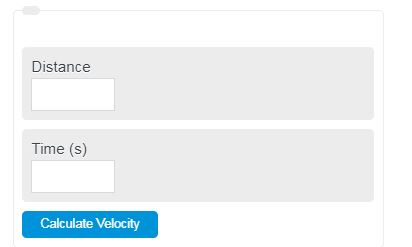Calculate the velocity of an object. Enter the object’s initial position, final position, and time elapsed to determine the velocity.
- All Velocity Calculators
- Acceleration Calculator
- Force Calculator
- Momentum Calculator
- Instantaneous Velocity Calculator
- Angular Velocity Calculator
- Net Velocity Calculator
- Displacement to Velocity Calculator
Velocity Formula
The formula for determining velocity can look something like this.
Velocity = (Position 2 - Position 1)/ Time (s)
To calculate the velocity, divide the change in position by the change in time.
Where positions 1 and 2 are described as a coordinate system in the x,y, and z planes. This change in position can also be considered as the total distance.
Velocity is known as the time derivative of displacement. This means that mathematically, and conceptually, it’s the rate of change in position with respect to time. It’s important to recall that it’s with respect to time because, without that, velocity would mean nothing. Using the derivative to calculate velocity is usually used when the position is described in some sort of an equation.
Acceleration is the derivative of velocity. If you think about this, it means that acceleration is the rate of change of velocity. Or in other words, the rate of change of the rate of change.
Velocity, just like acceleration, is all part of Newton’s second law of motion, which is derived from the formula for force, F=ma. Where F is force, m is mass, and a is acceleration. Velocity is also a property involved in momentum.
How to Calculate Velocity
Let’s take a look at an example of how to calculate velocity in a physics problem. Let’s say we have a baseball. We throw it from point A to point B and time it as it moves.
- First, we need to measure the distance from point A to point B. It’s important to only measure the horizontal distance as that is the velocity we will be calculating. Recall that velocity is a vector quantity so it has magnitude and direction. For this example, we will assume 25m as the distance.
- Next, we need to write down the time it took to move from point A to Point B. For this example, we measure 25 seconds.
- Finally, enter the information into the equation mentioned above. Velocity = 25m/25s = 1m/s
- Analyze the results and apply them to addition problems.
As we mentioned before, velocity, as well as other vector properties like acceleration and force, can be communicated as a function or equation. For example, acceleration could be displayed as a = 25 x^2 + 10, Where x is the position. To then calculate velocity from this function you can take the first derivative with respect to time. This resulting answer would be v = 25x/s, where x is the position.
Velocity Definition
Velocity is often described as the rate of change in the position of an object or system. Velocity is a vector quantity which means that it has a magnitude and a direction. For example, an object could be speeding along at 30m/s in the x-direction and 0m/s in the Y direction. Speed is the magnitude, and motion is the direction.

